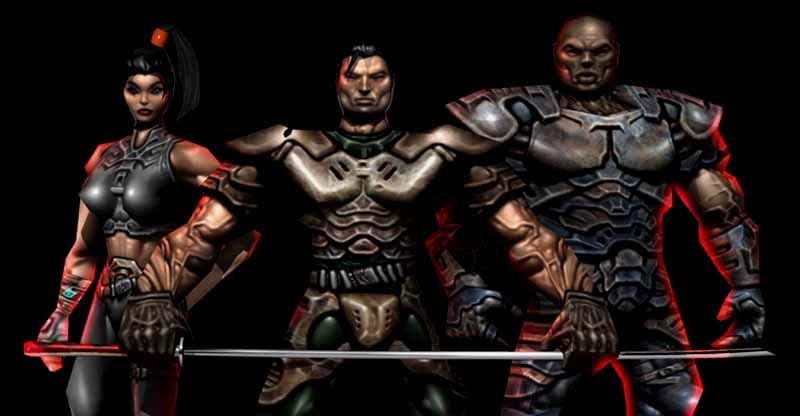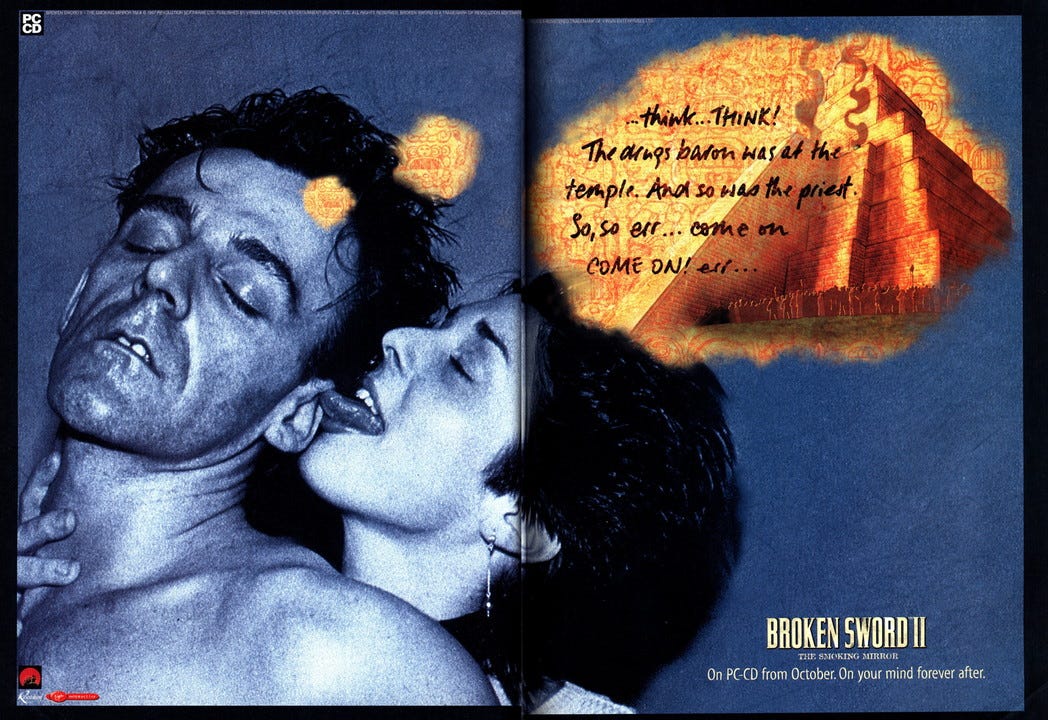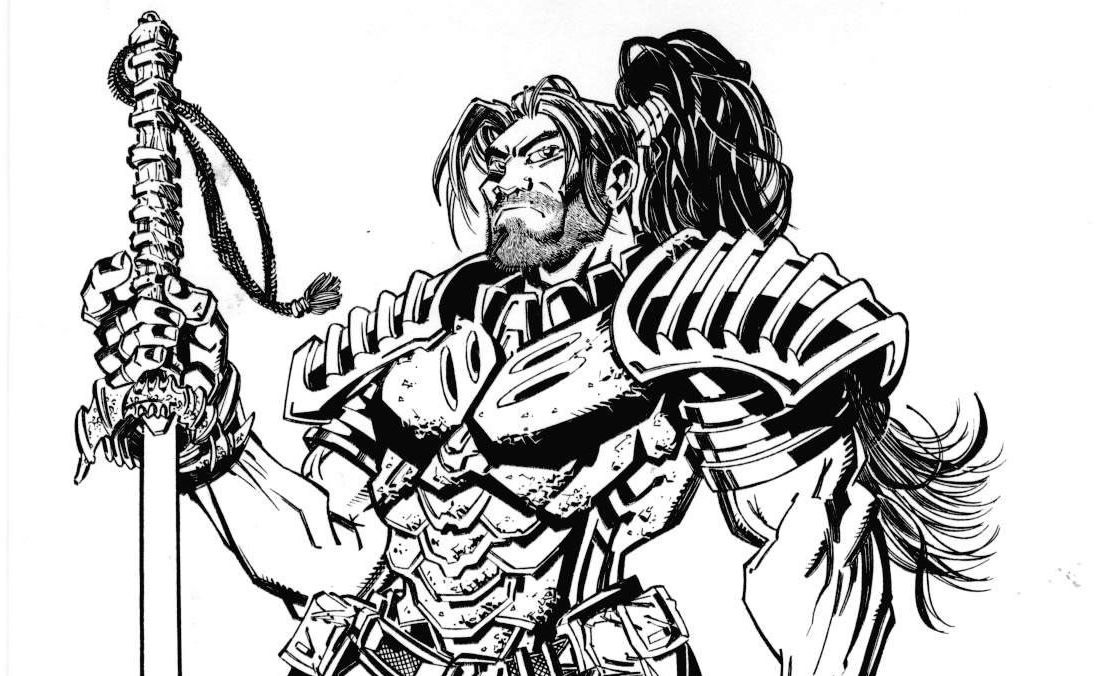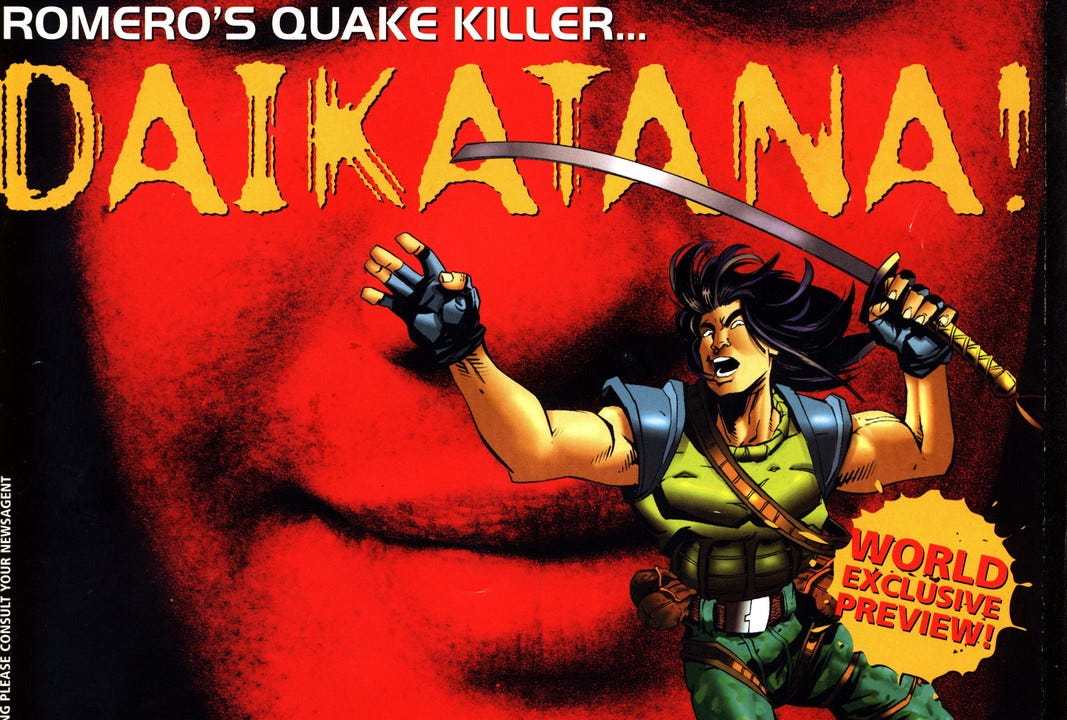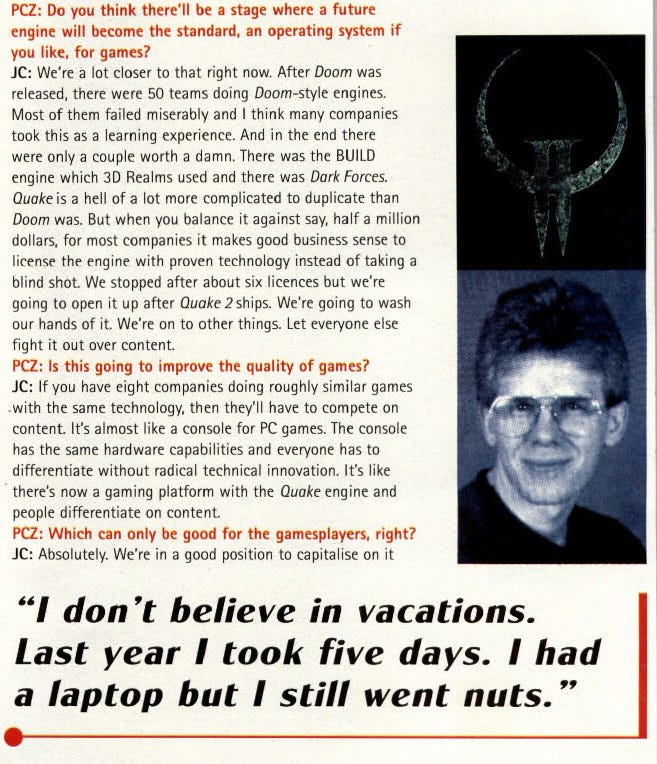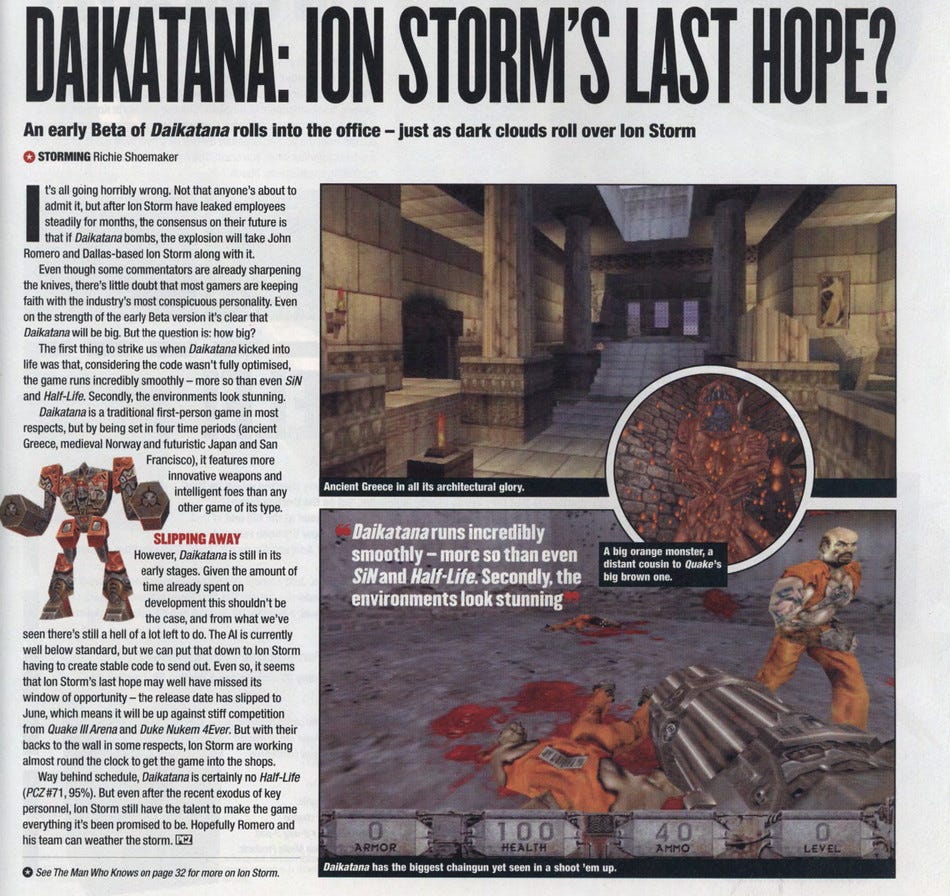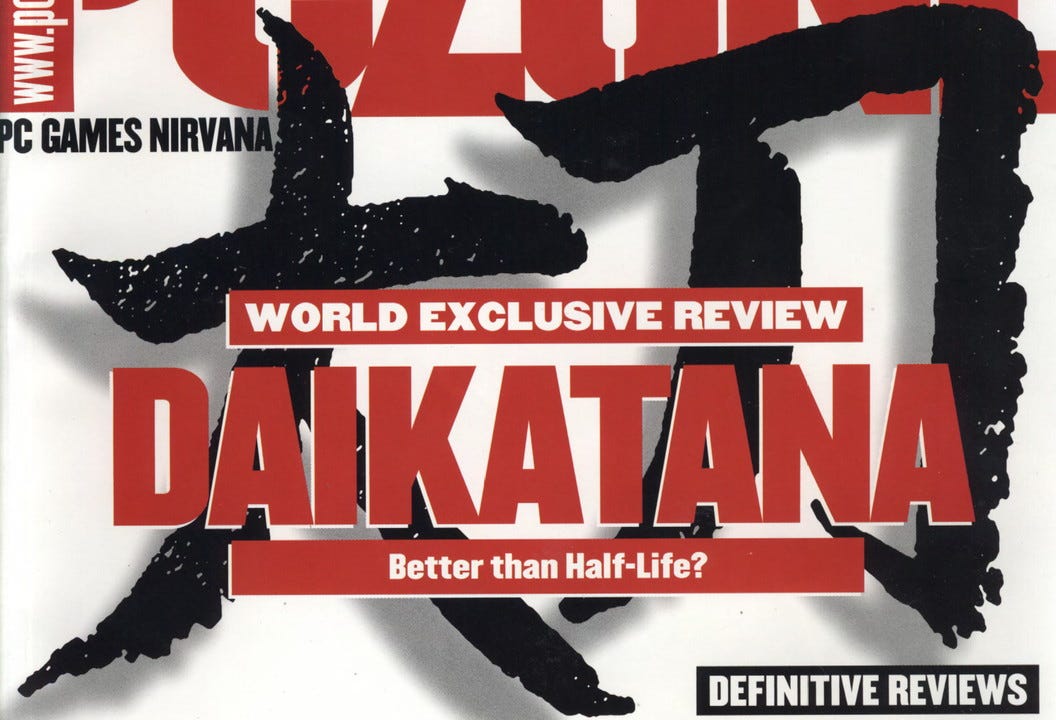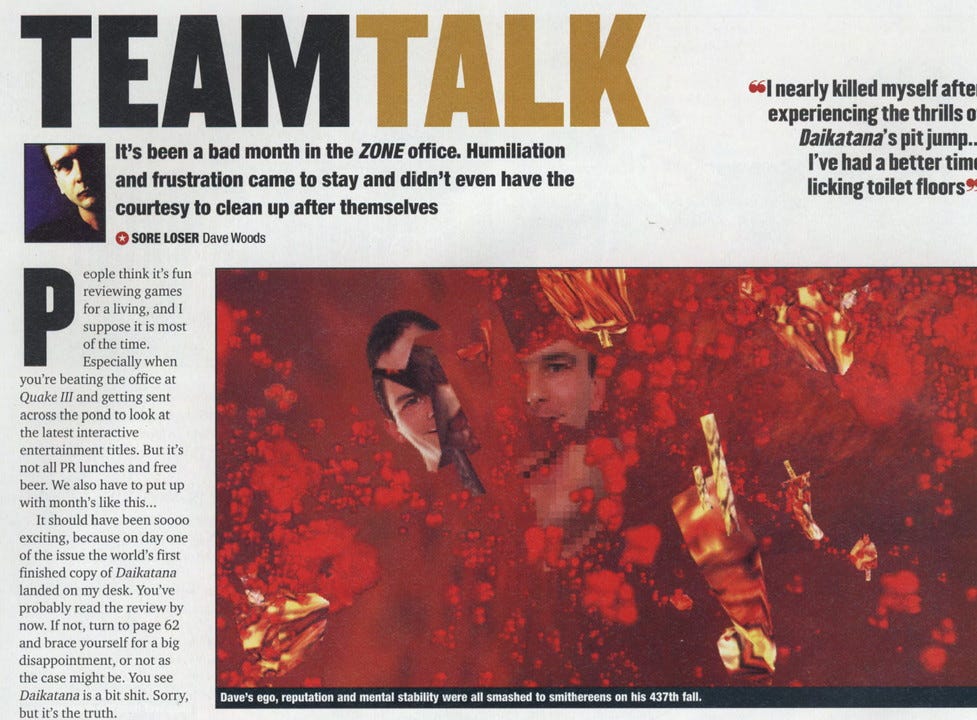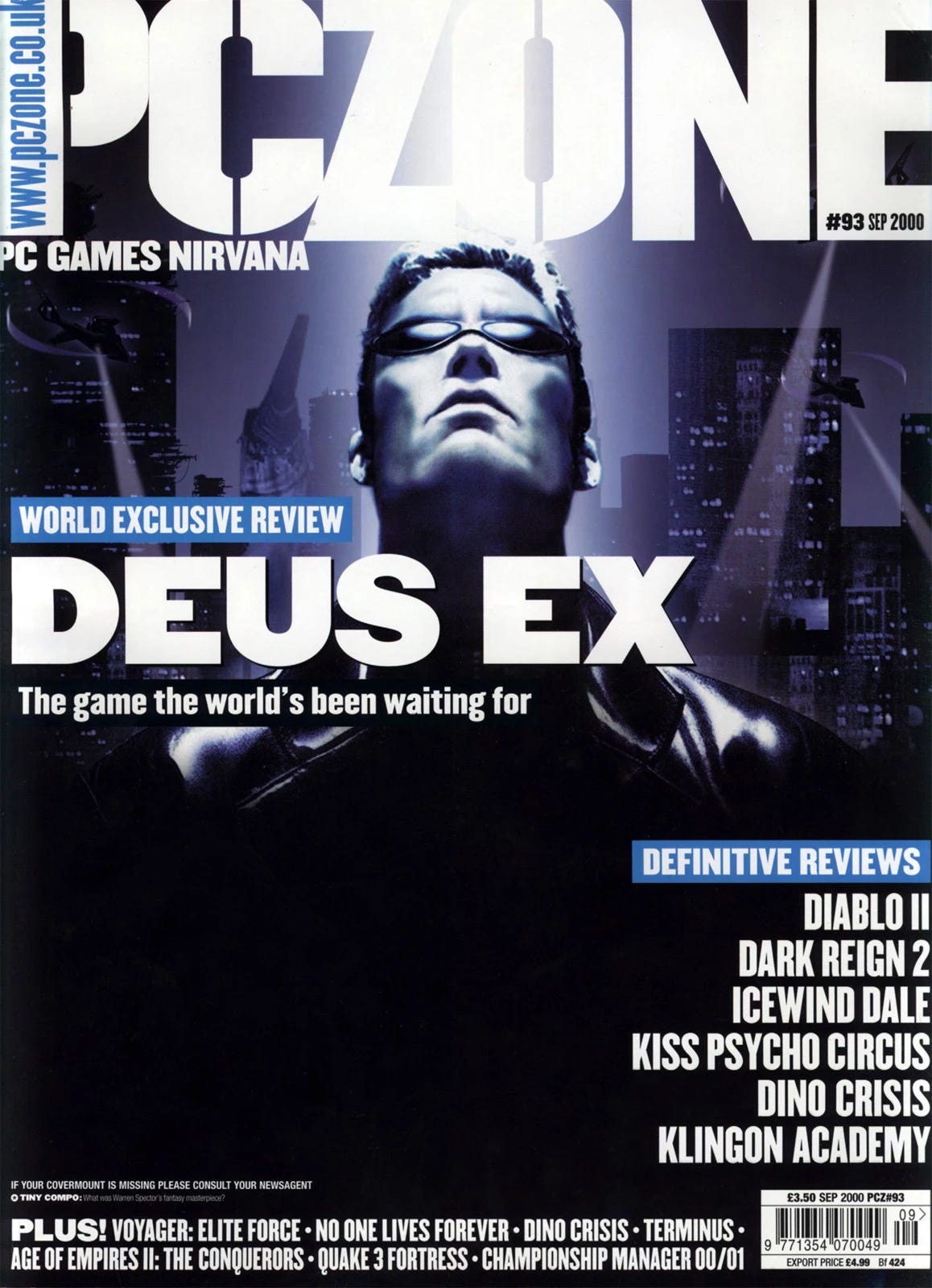Daikatana: When PC Zone made John Romero a pitch
It was the next big FPS from the rock star programmer behind Doom and Quake. Right up PC Zone’s street, you might think. And it was, until they, like everyone else, started to lose patience
'Oh dear. Oh dear, oh dear, oh dear.'
These were not, as PC Zone's then-editor Dave Woods acknowledged, 'the words that John Romero would want to see adorning the start of the first review of the full version of Daikatana'.
It was the early summer of the year 2000 and the game had finally been released. The largely negative appraisals it received were a fitting end point to a long and sorry tale that had once begun in a blaze of hype and excitement, especially in the pages of PC Zone.
Zone had been one of Doom's most enthusiastic ongoing champions, while id Software's follow-up, Quake, was the recipient of one of its more effusive appraisals, a 16-page magnum opus in Issue 43 (October 1996) by the magazine's resident FPS expert, the überfragmeister himself, David McCandless. (Yes, it was the '96%: fucking brilliant' one – you remember).
Quake, though, was John Romero's last contribution to id. During its development, he had clashed with fellow co-founder John Carmack, and upon its completion left the company to strike out on his own. Despite the evident excitement about Quake, attention soon focused on the phalanx of other first-person action games on the horizon: what would be next?
‘I beg your pardon, sir, you’re about to make me your what?’
Well, Quake II, obviously, the announcement of which soon followed in the pages of Zone a couple of months later. The previous month, Issue 44 (November 1996) had featured an update on two of Quake's one-time rivals: Prey, from 3D Realms, whose rumoured demise was poo-pooed as a 'speed bump' and 'minor setback' by George Broussard; and Epic's Unreal, the subject of slightly more enthusiastic and excitable speculation, although still acknowledged as 'an engine without a game'.
Both were expected to be released at some point in 1997, a target that Unreal missed by a year or so, while Prey didn't see the light of day until 2006. (And we haven't even mentioned 3D Realms' other big FPS, the continuing adventures of the big blonde guy who lost out to Quake in ‘96, which is a whole other story).
Daikatana, then, clearly wasn't the only big-name game to suffer significant release-date slippage, so it seems in some ways slightly unfair that its name, and that of its creator, became so synonymous with delay and disappointment. However, it could also be argued that Romero hardly helped himself, and not just by signing off on that notorious advertising campaign advising potential purchasers of the game that he would make them his 'bitch', but also by cultivating a growing reputation for Hollywood-style arrogance and hubris.
(As an aside, this writer could find no evidence of the notorious ad in the pages of Zone, although it's entirely possible that it was lost amongst a mass of equally awful but long-forgotten campaigns, such as the use of a leather-clad model to promote the game FX Fighter Turbo ('fancy trying one of your special moves on me?') or a promo for Broken Sword II (which, let's not forget, was a point-and-click adventure game starring a mild-mannered American tourist) showing a woman sticking her tongue in a man's ear. Throw in multiple ads for Dennis Publishing lads-mags Maxim and Escape, the latter featuring the frankly harrowing promise of seduction tips from Peter Stringfellow, and you'll perhaps forgive me for missing a red page with a slightly rude phrase written in the middle).
Willy Wonka’s LSD Factory
The June 1997 edition of Zone (Issue 51) featured the first mention of Romero's new studio, Ion Storm, and the initial crop of games to be released, including Daikatana, fellow ex-id man Tom Hall's Anachronox, and a real-time strategy game from Todd Porter called Stranded, which never saw the light of day. According to the piece, 'Both EIDOS and Ion Storm insist that Daikatana's pre-Christmas release date is "totally realistic", and there's even a chance that it may be released before Quake 2 and Unreal.'
The following month's issue (52) featured an interview with Ion Storm and what Zone called a 'first look' at the game, which amounted to a couple of bits of concept art, and a promise of a full preview to follow. The interview, meanwhile, was conducted by David McCandless, and is of a type that was entirely in line with similar pieces in music magazines of the day – i.e. spend a day with the interviewee/s and get a bit wasted – but would no doubt now prompt nine-hour reaction videos from outraged YouTubers wanging on about corruption and collusion.
Unsurprisingly light on detail, save for the fact that the game will use the Quake engine, it's a whirlwind of drunken boasting across multiple locations, with Romero throwing around lots of numbers relating to weapons, levels, polygons and frame rates, while CEO Mike Wilson claims that their Dallas offices are 'the Willy Wonka's Chocolate Factory of Gaming', and feature 'Oompa Loompas' and 'LSD dispensers in the hall'.
Towards the end of the piece, though, after Romero has elaborated on the concept of a deathmatch game known as a 'Milk Match' ('whoever loses has to drink some milk out of our jug of milk which has been sitting there for five months... [it] comes out as yellow blocks like cheesecake') and the other members of Ion Storm have spoken a little about their projects (with Todd Porter’s aforementioned RTS Stranded now referred to – somewhat confusingly – as Romora), there is some insight on what he wants Daikatana to be: 'The one-player game [in Quake] really wasn't that great. I knew Doom was going to be the biggest game ever. Just like I know Daikatana is going to be bigger.'
A two-part preview across Zones 53 and 54 (which included some actual screenshots) elaborated a little further, and established some of the basic principles of the single-player experience that remained in the final version of the game: the protagonist, Hiro Miyamoto (the concept art for whom, the piece notes, bears 'an uncanny resemblance to John Romero') and two sidekicks, Mikiko Ebihara and Superfly Johnson, go on a time-travelling quest to retrieve the titular Daikatana (which literally means 'big sword' in Japanese), with each of the four episodes set in a different time period, including escapades in Ancient Greece and the Dark Ages.
Still, such details have to be picked out of an otherwise chaotic back-and-forth with Romero, during which a lot of the focus seems to be on the multiplayer aspect of the game. The second part of the preview confirms that Ion Storm's offices in the swanky Texas Commerce Tower are more or less as described, LSD dispensers notwithstanding: 'Every desk has... two Pentium 200s with 64Mb of RAM (minimum) with 21-inch monitors. Every section has its own snackbox (contents: popcorn, Opal Fruits, Hershey bars, and other healthy stuff). There are two fridges, containing an endless supply of every soft drink imaginable. There's a fussball table. A table tennis, sorry, “ping pong” table.' An intention to move to the penthouse floor of the building, and fill it with more 'cool shit' is also discussed.
And what about the game? Well, hidden away down at the bottom of the page of Part 2 is a note that quietly acknowledges Daikatana's slightly underwhelming showing at 1997's E3 and that some of the team have taken the criticism to heart. The mixed reaction is put down to an early (20% complete) build featuring standard VGA graphics, which fail to capture the imagination in a world where early 3D acceleration is increasingly starting to dominate.
Macca, now going by the name 'UberGibKing', is unconcerned: 'Those in the know judge games of design and concept.'
'We know it's going to be great,' says Romero.
A couple of biros and a bit of paper
With the benefit of hindsight, it's easy to say that anyone could have seen Ion Storm's downfall coming. In the movie version of the story, this is where our hero gets too big for his boots, spends all his money, and focuses on the wrong things.
At the time, though, John Romero was a guy who had made Doom, and then Quake: who would have bet against him? (Plus, it's also worth pointing out, he was only 29 years old when he started Ion Storm, and if you're anything like me, the major financial decisions in your life at that time would have been whether to draw out cash on your credit card to pay for a taxi because you fell asleep on a train on the way home from the pub).
It probably didn't help that Romero's ex-colleagues took the complete opposite approach when it came to the press. Macca’s interview with John Carmack in Issue 55 (October 1997) is (both figuratively and literally) a relatively sober affair: there is an absence of any ‘cool shit’ in his office, which is described as 'spartan... six workstations sit humming on a row of desks. A couple of biros and a bit of paper can be seen.'
Moreover, Carmack's understated nature belies a steely confidence bordering on arrogance that arguably exceeds that of old sparring partner Romero. In a breath, he dismisses his rivals: 'A year ago, Quake had been out for around a month and everyone was talking about how these Quake killers were right around the corner... And still none of them – not a single one – has shipped.'
Pressed on the imminent release of LucasArts' Jedi Knight, Carmack holds firm: 'With Jedi Knight, the content's good, but it's not a technologically superior engine and they know it. They're doing the same thing that I am – but they're still half a step behind.'
And, without Daikatana even being mentioned by name: 'There's some sniping about who's doing what and all that... but you can look at it and remind yourself that if Ion Storm have a spectacular success we'll probably make more money than anyone there makes out of it – because we've got a big chunk of the royalty.'
Below a black and white shot of the man himself, wearing glasses that were surely out of fashion even in the late 90s, the interview finished with Zone asking if Carmack planned to take a break once Quake II was done: 'I don't believe in vacations. Last year I took five days and went to England. My God, I was nuts by the time I got back... I had a laptop with me but it wasn't the same.'
If gaming was supposed to be the new rock and roll, and PC Zone was very much in the camp that believed it was (although I’m sure it would never have lowered itself to such tired clichés) [check this - Ed.] then this wasn't the guy to be backing against Romero.
Thing is, though, Carmack turned out to be right. Jedi Knight was reviewed in the same issue, and received a score of 94%, but it wasn't the future. And in the absence of games that truly rivalled Quake, the top FPS titles of the past 12 months had included the likes of Blood, Outlaws, Shadow Warrior and Redneck Rampage, all of which still used sprites rather than polygons for their enemies. Only Hexen II seemed to stand up to Quake on a technical level – because it used the Quake engine.
As tidbits of news on the supposed Quake killers continued to be delivered in dribs and drabs, id delivered its own, Quake II, in time for Christmas. There was to be no 16-page allocation for the review this time - the überfragmeister had to make do with only three - but he went one better with the score ('97%: It's Doom III and it's beautiful' - Issue 59).
If Daikatana was coming out any time soon, then this was the game it would have to beat, along with a whole host of other new FPS games on the horizon: there were glimpses of Unreal, SiN and Half-Life in the pages of Zone around this time. (And also a game called Duke Nukem Forever, but – like we said earlier – we can only focus on one extremely delayed disappointment at a time).
Meanwhile, Ion Storm appeared to have gone a little quiet. In Issue 60, McCandless spoke to Romero again and found him in a slightly less ebullient mood, having admitted elsewhere that Quake II was the best game he'd ever played, and in the midst of moving Daikatana over to the Quake II engine. The following month, some other members of the development team featured in a further preview (whether any of them saw it through to the end release is another matter: a quick check of the credits lists those identified in this piece as ‘additional employees’, which suggests they didn’t).
A completely genuine marketing strategy
The next glimpse of the game was in June 1998 (Issue 64), with confidence in Daikatana evidently still high at Zone towers, as a Hot Shots preview proclaimed that ‘Romero and his team were right to delay Daikatana… [the game] is looking absolutely brilliant’ while praising the level design and the AI of the sidekicks. What exactly this was based on is unclear, but the release date had again slipped to September… which soon became December, as announced in the August issue (66), by which point a post-redesign Zone found it necessary to remind readers that John Romero was ‘one of the men behind Doom and Quake’ while still espousing the virtues of further delays as ‘ample proof of Ion Storm’s commitment to making the best first-person shooter around.’
The following month, Ion Storm’s first game finally made it into the pages of PC Zone. Dominion: Storm Over Gift 3, a real-time strategy game that Todd Porter had once worked on at 7th Level (but was not the once-mentioned Stranded/Romera title that may or may not also have been called Doppelganger) and subsequently sold back to him at Ion Storm, was reviewed by Phil ‘Wandy’ Wand in Zone 67, and received a score of 43%, along with some very unflattering comments.
As December arrived, Daikatana earned another brief mention in the Hot Shots preview feature, as it was explained, with the patience of a long-suffering spouse who hasn’t had quite enough of their partner’s bullshit excuses (but will frankly be absolutely bloody furious if this turns out to be a lie as well, ok, Neil?) that the game was delayed not for technical but ‘marketing strategy’ reasons on the part of publishers Eidos. (It’ll be ready by March 1999, darling, I promise).
Even if the ‘marketing strategy’ line was true (which, of course, it wasn’t), it wouldn’t have made much sense: quality first-person shooters were arriving by the bucketload and although going up against the likes of SiN, Shogo: Mobile Armor Division and the new king, Half-Life, might not have been the greatest idea, waiting for the bar to be raised yet again and then putting your game out didn’t seem like the brightest idea either.
News about Daikatana itself quickly became overtaken by tales of unrest and upheaval at Ion Storm. In PC Zone Issue 72 (January 1999), Paul ‘Prezzer’ Presley noted the departure of 17 members of staff over the previous two months. While Romero shrugged off the news, claiming the game was virtually finished anyway, an unnamed UK developer was quoted as saying, ‘The end of every project is a painstaking time. If a bug appears, the original programmer might fix it in half an hour. If he’s not there, some other poor sod might spend three days just getting his head round the initial code. Plus, if Daikatana is as finished as Romero says, why are these guys passing up a chance to put it on their CVs?’
In Issue 74 (March 1999), ‘The Man Who Knows’ (Zone’s once-regular gossip column) followed up by noting a story in the Dallas Observer which quoted heavily from some leaked e-mails, including one from Todd Porter (who had replaced the departed Mike Wilson as CEO at the end of 1997) following a meeting with Eidos, with the conversation characterised thus: ‘VERY VERY VERY concerned about Daikatana not shipping on time… VERY VERY VERY concerned about people leaving Daikatana - though I tried to assure them that most of those who left were shit anyway.’
Meanwhile, Richie Shoemaker (whatever happened to him?) got his hands on a beta version of the game and, while noting some positives, also came to the conclusion that it was not close to release: ‘Daikatana is still in its early stages. Given the amount of time already spent on development this shouldn’t be the case, and from what we’ve seen, there’s still a hell of a lot left to do’.
‘We may as well have gone to Blackpool’
The game that was going to beat Quake had missed its chance to beat Quake II, and was arguably now in a race to beat Quake III into the shops, even though by this point the idea of what Quake actually was had evolved yet again (Quake III: Arena was the cover game of Issue 75, which also featured shots of Unreal Tournament, with both entirely focused on deathmatch play).
Zone 74 also featured a preview of Command and Conquer: Tiberian Sun, another much-delayed title, but one which again arguably benefited from keeping a low profile rather than repeated attempts to build anticipation. That month’s ‘Meet the Team’ feature asked Zone’s writers: would the likes of Tiberian Sun and Daikatana live up to the hype? David McCandless, then in the twilight of his Zone career, said of the latter: ‘It’s a damn shame, but probably not.’
1999 brought more tales of Ion Storm unrest, with the sacking of Porter earning a brief mention in PC Zone’s 79th issue. A Christmas release was repeatedly mooted, but the festive issue of PC Zone (84) featured a preview by Steve Hill which started with the tale of a visit to Ion Storm earlier in the year: ‘Dallas, Texas: February 1999. Atop the Ion Storm skyscraper, the cream of the UK gaming press is assembled for a final look at the heavily delayed Daikatana prior to its pending release. Or so we were told… The long and the short of it is that Daikatana was nowhere near finished, and we might as well have gone to Blackpool.’
Romero, understandably, was continuing to talk the game up, again emphasising the changes in environments, weapons and enemies with each location (‘It’s pretty much four complete games in one’) and contrasting this with Doom: ‘People that got the shareware version of Doom, they’d download it, play it and finish [it]. They thought they’d played Doom, been there, seen it, done it… They’ll play Daikatana, starting with the first episode and think, “Wow, that was really cool, that was really great”. Boom! Go to another episode. “Holy Cow! Y’know, this is totally different.” Boom! “Jesus Christ, what’s going on?”’
The preview continued with a follow-up playtest at publishers Eidos in October, which saw Hill noting a ‘mixed response from the assembled loafers. It’s certainly playable, but still lacking in sidekicks, and with the eponymous magic sword being kept as “a surprise”.’
The cover of the January 2000 issue (85) prom0ised ‘Definitive Reviews’ of a list of games that included Daikatana, but inside the magazine, such a review was nowhere to be found. A slightly exasperated acknowledgement was found in the pages of February’s ‘Millennium Issue’ (86): ‘It’s getting beyond a joke now. Daikatana still isn’t with us, despite the promise of review code for the January issue. (Eagle-eyed readers might have noticed it on our cover). Don’t expect a review next month and you won’t be disappointed.’ Meanwhile, Quake III was reviewed, adding further to the list of acclaimed first-person games (including Kingpin, Aliens vs Predator, System Shock 2 and Unreal Tournament) that had entered the fray in recent months.
The turn of the millennium prompted much navel-gazing and speculation about the future of gaming from Zone, with 20 top developers contributing their thoughts on the subject, alongside a slightly less serious piece from Charlie Brooker called ‘The Shape of Things to Come’ which featured seemingly flippant news stories from the future. (Those from dates that have now passed - ‘2007: Bug-Fix Patch Wins Full-Price Release’ and ‘2018: Polygon Count “Beyond Calculation”’ - seem to have been alarmingly prescient. Such ideas might make for a good TV show, I reckon.)
1996, and Quake, seemed like a very long time ago. Under any circumstances, games with a development cycle as troubled as that of Daikatana would have had to battle the odds to succeed, but having one that spanned a period of such rapid technological advancement as the late 90s meant it faced an almost impossible task.
But there’s always that chance, isn’t there? A small possibility that a great game might somehow emerge and make everyone’s sniping and complaining seem rather silly. (In response to the Dallas Observer piece, Ion Storm’s Mike Breslin was quoted in Zone 75 as saying ‘You see this in Hollywood all the time. Look at Titanic - all they did was talk about how long it took and how much money it took to make this movie. And it came out, and then it was a great movie, and everybody forgot about all the negativity, the delays and everything else.’)
It’s the kind of optimistic feeling that Zone was probably banking on when the exclusive review finally arrived in Issue 91 (July 2000), tantalising the reader with the question, ‘Better than Half-Life?’
No, it’s a bit shit actually
Of course, it wasn’t, as anyone in WH Smiths who ventured beyond the cover and into the review itself would quickly have found out. (My memory is that maybe the magazine was wrapped in a plastic cover around this time, in order to prevent such chicanery, although perhaps I was just a Zone purist who wouldn’t open the magazine until the money had been handed over).
A long list of shortcomings was reeled off (the use of the Quake II engine, the level design, the enemy AI, the annoying sidekicks, the controversial ‘save gems’ which took away the PC gamer’s favoured FPS staple - the habi6tual quick-save…) and a succession of other Zone writers were lined up to give their thoughts, all of which concurred with those of main reviewer Woods. Big movies were indeed mentioned as points of comparison - but they were giant flops like Ishtar and Waterworld rather than Titanic.
Shortly before issuing a score of 53%, the review concluded:
‘We’re not kicking Daikatana because it’s an easy target. We were actually looking forward to playing it and proving people wrong by giving it a decent score… If it had been released on time then it would have gone down pretty well. As it is, we’re sure that Eidos and John Romero will be pleased to see the back of it.’
Woods then returned in the back-page feature ‘Team Talk’ to offer some further thoughts:
‘[This month] should have been soooo exciting, because on day one of the issue the world’s first finished copy of Daikatana landed on my desk. You’ve probably read the review by now. If not, turn to page 62 and brace yourself for a big disappointment… You see, Daikatana is a bit shit. Sorry, but it’s the truth.
‘But as a professional games reviewer I can’t just look at a game for ten minutes, say it’s a bit shit, then launch into Quake III. Despite the fact that I know it’s not going to get any better, or even improve enough to make the experience even slightly enjoyable, I’ve got to play it all the way through. And then go into multiplayer mode for a couple of days. And then kill myself.’
By some strange coincidence, the same piece later referred to a brief return to Zone’s pages for David McCandless, who had covered the Quake III championship in the same issue. The boozy, boastful previews of Daikatana seemed like a distant memory (partly, I guess, because they were). Reading it all back now, though, it’s just about possible, for a moment, to imagine another world in which Daikatana had been released on time, and reviewed enthusiastically by Macca, in the days of a slightly edgier incarnation of Zone.
The new action role-playing benchmark
A couple of months later, in Zone Issue 93 (September 2000), the buying public had their say in the monthly readers’ reviews section, Feedback. The general consensus of opinion was that the review had, if anything, been rather too kind: ‘It deserves about 12 per cent, perhaps even less! What has John Romero been doing for the last four years?’; ‘This is the worst excuse for a PC game I have ever seen. I couldn’t un-install it quick enough’; ‘I went off to buy it… 20 minutes later I was groaning in misery and smacking my head against the monitor’.
As it turns out, though, that was the last real mention of Daikatana in Zone (budget re-releases notwithstanding). Ion Storm had another new game out, and reviewed in the very same issue: Deus Ex, another Zone exclusive, received a score of 94% (‘the new action role-playing benchmark’).
To the extent that Eidos was ever able to have a coherent ‘marketing strategy’ when it came to Daikatana, at the last moment it had somehow managed - whether by accident or design - to bury Ion Storm’s great big failure, by following it up with their greatest success.
0




